#orange fronted parakeets
Explore tagged Tumblr posts
Text
A female pair of Orange-fronted Parakeets was forcibly removed from their nest – which they had successfully defended from a heterosexual pair – in order to "allow" the opposite-sex pair to breed in their stead (based in part on the mistaken assumption that female pairs are unable to be parents).
"Biological Exuberance: Animal Homosexuality and Natural Diversity" - Bruce Bagemihl
#book quote#biological exuberance#bruce bagemihl#nonfiction#lesbian#orange fronted parakeets#aratinga canicularis#bad science#breeding pair
0 notes
Text
BOTD: Orange-fronted Parakeet

Photo: Peter Wilton
"Parakeets are fairly small parrots, usually with a relatively long and somewhat pointed tail. This species is fairly common in tropical lowlands, mainly in semiopen areas with scattered trees, woodlands, and locally in towns and suburban areas. Often in small flocks or in pairs."
- eBird
#birds#orange fronted parakeet#birds of north america#north american birds#parakeets#parrots#birds of mexico#birds of central america#birding#birdblr#birblr#bird watching#bird of the day#Eupsittula canicularis
16 notes
·
View notes
Text
Same-sex couples often sit side by side – sometimes for half an hour or more at a time – preening and nuzzling each other while fluffing their plumage.

"Biological Exuberance: Animal Homosexuality and Natural Diversity" - Bruce Bagemihl
#book quotes#biological exuberance#bruce bagemihl#nonfiction#orange fronted parakeet#aratinga canicularis#preening#nuzzling#fluffed up#plumage
4 notes
·
View notes
Text


Today’s pixel art bird is the rufous-collared sparrow! This photograph was taken in the same tree as my emerald toucanet and orange fronted parakeet photos if you look closely. Grey-headed chachalacas also abounded.
Not to be confused with the rufous-crowned sparrow, this sparrow species is widespread in South America. In Costa Rica, it is known as “come maíz.”
P.S. You can find this pixel art bird as a sticker here. :)
#rufous-collared sparrow#pixel art#bird art#birds of tumblr#image description in alt#birdwatching#Zonotrichia capensis
17 notes
·
View notes
Text

December 13, 2023 - Malherbe's Parakeet, Kakariki Karaka, or Orange-fronted Parakeet (Cyanoramphus malherbi) Formerly found throughout much of New Zealand, these parrots now remain in only a tiny range on the South Island and have been released on several offshore islands. They feed on invertebrates, including scale insects and caterpillars, buds, flowers, young leaves, berries, and seeds, often foraging high in tall trees but also on or near the ground. Nesting in cavities in tree trunks or branches, females incubate the eggs and brood the chicks while males gather food. Both parents feed the chicks, though females may feed them exclusively for the first few weeks. Pairs may nest several times in a row in years when food is abundant. They are classified as Critically Endangered by the IUCN due to continued population declines driven mostly by introduced predators, including rats and stoats, as well as habitat degradation and disease.
#malherbe's parakeet#kakariki#parrot#cyanoramphus malherbi#bird#birds#illustration#art#woodland#birblr art
59 notes
·
View notes
Note
Peaches with sashnetra for writing please?
I don't remember which one of my friends had a pet named Peaches (it was a hamster iirc) but that memory sparked inspo for this drabble
also partially inspired by ria telling me her cats are named after food heehee :3
Meow
"Yes, hello to you too," Sasha said as she barely acknowledged the cat at the apartment's front door. She took off her jacket and work heels as she felt the cat's soft fur circling her calves.
Meow
"I'll feed you in a moment," She answered the cat as she took her cell phone from her purse. Sasha was exhausted from a long day at work, all she wanted was to get in some comfortable clothes and have greasy delivery pizza with her girlfriend.
The cat jumped on the back of the nearby recliner, making its presence known to Sasha, meowing again. "Okay, let's get you some food,"
Sasha scratched the cat's head before heading towards the kitchen. It was only when she made it past the threshold that the realization hit her.
They didn't have any cat food in the apartment.
They didn't even have a cat.
As Sasha stared at the cat in shock, she mustered herself enough to call out down the hall.
"Anetra?"
"In the bedroom!" her girlfriend's voice called back.
Sasha picked the orange cat up, realizing it was a female. She had a collar with printed blossoms on it.
"What is this?" Sasha said as soon as she entered the bedroom. She held out the cat to show Anetra.
"That's Peaches," Anetra simply said as she searched through the documentary options on Netflix. A relaxed white cat sat in her lap, she mindlessly stroked its fur.
"Okay...then what is that?" She asked apprehensively. Anetra did not seem concerned that there was not one, but two cats in their living space all of a sudden.
"This is Cream." She rubbed one finger under the white cat's chin, purring loudly.
"So why are Peaches and Cream here?" She asked before Anetra settled on something to watch.
Anetra sighed, "Mirage. She does things like this all the time." she explained.
"Like what?" Sasha met Anetra's lifelong best friend a few times since they started dating, but didn't know much more about her.
"She gets a cute animal, takes care of it until she gets bored, and then gives it to me," Anetra said. "She's had so many pets. Hamsters, turtles, parakeets, everything."
"And she just hands them off to you?" Sasha asked.
"Yup, she knows I hate seeing animals get abandoned," Anetra said with a shrug. "She tried to give me a German Shepard puppy before, but we ended up finding a nice farmhouse for her,"
Sasha looked at Cream who happily fell asleep in Anetra's lap. She looked down to see Peaches purring in her arms. Maybe having two cats wouldn't be such a bad thing.
"Should we keep them?" Sasha asked as she sat on the bed next to Anetra. She always wanted a pet but was usually too busy to put in the love and care needed on her own.
"They are already here, aren't they?" Anetra joked as they settled in to watch the nature docuseries.
Peaches and Cream settled at the other end of the bed curled up together. Luckily Mirage left food and bowls for the cats when she dropped them off.
"At least Mirage picked out good names," Sasha pointed out.
"Oh, actually I renamed them," Anetra said. "The names she picked out were...something else,"
"What were they?" Sasha asked with a raised eyebrow.
Anetra pointed at Peaches, "Dream," she moved to point at Cream, "and Sicle"
"Dreamsicle?"
"Now you know why she gave them to me,"
25 notes
·
View notes
Text






12th April 2024: Speckled Wood on dandelions out the front, Canada Goose and dandelions at Lakeside Country Park, tree out the back and green alkanet and Great Crested Grebe and chicks on a smashing day of walks and sightings at and around home.
I saw all of the seven species of butterfly I've yet seen this year today with Brimstone, Peacock, Red Admiral, Small Tortoiseshell, Small White and Orange Tip seen too which was brilliant. I also had a good day for birds heard with Blackbird and Song Thrushes' lullabies, the strong spring burst of Chiffchaff and Ring-necked Parakeet and Green Woodpecker. Other highlights today were Moorhen, Buzzard, Goldfinch, Great Tit, Blue Tit, House Sparrow, Lesser Black-backed Gull, Herring Gull at home snake's-head fritillaries, white deadnettle, mouse-ear chickweed, quite late now lesser celandine and groundsel.
#great crested grebes#green alkanet#dandelions#speckled wood#canada goose#photography#birdwatching#chiffchaff#small tortoiseshell#brimstone#red admiral#orange tip#spring#butterflies#2024#outdoors#outside#walking#friday#home#herring gull#lakeside country park#europe
2 notes
·
View notes
Text
image id: four digital paintings showing extinct animals interacting with humans in various ways. a person in a cowboy hat and red shirt rides a quagga, which is wearing a saddle and bridle. a person crouches down on a forest floor, holding a thylacine by the collar as they point forward, the thylacine looking in the direction they are pointing. a person wearing orange winter gear and goggles stands in front of a snowy outcrop, holding up a great auk with their hand under it's wing, smiling warmly. a person smiles happily as four carolina parakeets perch on their arm, one on their shoulder. they're holding a small cup of sugar water in one hand. end id.
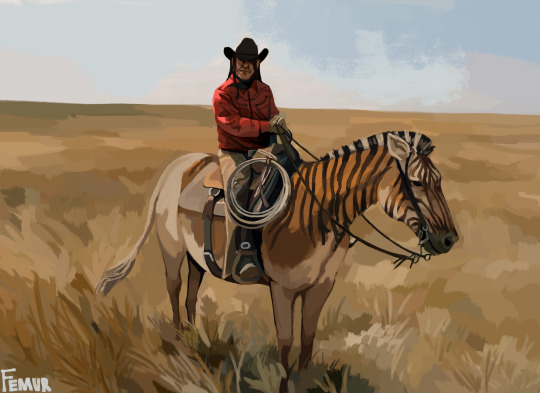
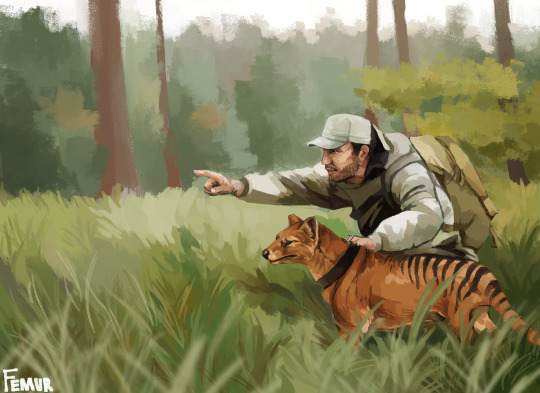
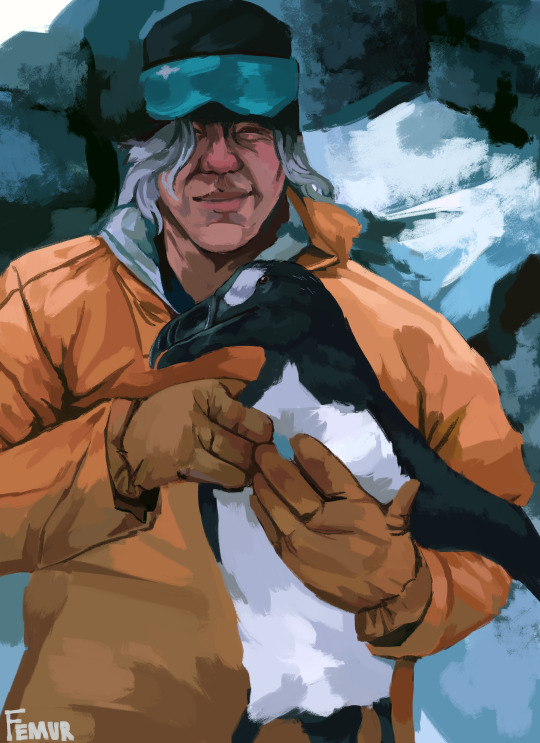
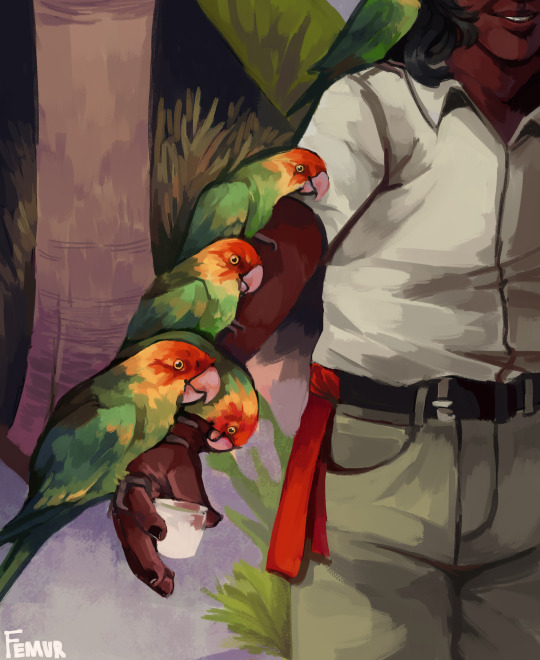
Something that could have been
18K notes
·
View notes
Text

INKTOBIRDSNZ DAY 17-20
Day 17: Warou/Welcome Swallow
Day 18: Kākāriki Karaka/Orange-Fronted Parakeet
Day 19: Weweia/NZ Dabchick
Day 20: Tāiko/Black Petrel
1 note
·
View note
Text

Kākāriki Karaka / Orange-fronted Parakeet. 1976. Gouache and coloured pencil. Eileen Mayo.
212 notes
·
View notes
Text
Both male and female homosexual pairs also occur in Orange-fronted Parakeets.
"Biological Exuberance: Animal Homosexuality and Natural Diversity" - Bruce Bagemihl
#book quote#biological exuberance#bruce bagemihl#nonfiction#orange fronted parakeet#aratinga canicularis#homosexual#gay#lesbian
1 note
·
View note
Text
Looks like that nest would be one of these,
One of the stragest places that parrots nest is in termite mounds. While this may seem to be the oddest place of all, it is a surprisingly common. At least 34 species, about 10% of all parrot species, have been found nesting in termite mounds. Most of the species that nest in termite mounds are small like the Grey-cheeked Parakeets (Brotogeris pyrrhopterus), Green-rumped Parrotlet (Forpus paserinus), and Orange-fronted Conure (Aratinga canicularis) and the Hooded Parrot (Psephotus dissimilis). Some species use terrestrial termite mounds, like the Hooded Parrot, but most use termite mounds that are located in trees that may be 6 to 40 ft. high or more depending on the area. The strangest thing about nesting in termite mounds is that the parrots almost always choose mounds where the termites are still present. As the birds excavate their nest cavities, the termites rush to the broken sections to defend their colony from the avian invader. Fortunately for the birds, the soldier termites have no mandibles and can't bite. Instead, the major defence of the termites is to shoot small quantities of a sticky irritating glue at the feathered attacker. From personal experience I know that this glue has little effect on human skin and is likely only mildly irritating to the excavating birds. As the birds continue to excavate, the termites become acoustomed to the comings and goings of their new neighbors. Eventually the termites seal off their passageways that lead to the bird nests, leaving the birds and termites living peacefully in complete isolation.
1K notes
·
View notes
Photo

Parrot studies!
#cyanopsitta spixii#spix's macaw#calyptorhynchus banksii#red tailed black cockatoo#aratinga canicularis#orange-fronted parakeet#parrot#art#artwork#psittacidae#conure#macaw#cockatoo#bird
236 notes
·
View notes
Text
Galahs and Peach-faced Lovebirds are gregarious birds, gathering in large flocks that can number up to several hundreds in Lovebirds and up to a thousand in Galahs. (...) Orange-fronted Parakeets are also highly social, traveling in groups of 12-15 birds (often composed of mated pairs) and sometimes forming flocks of 50-200.
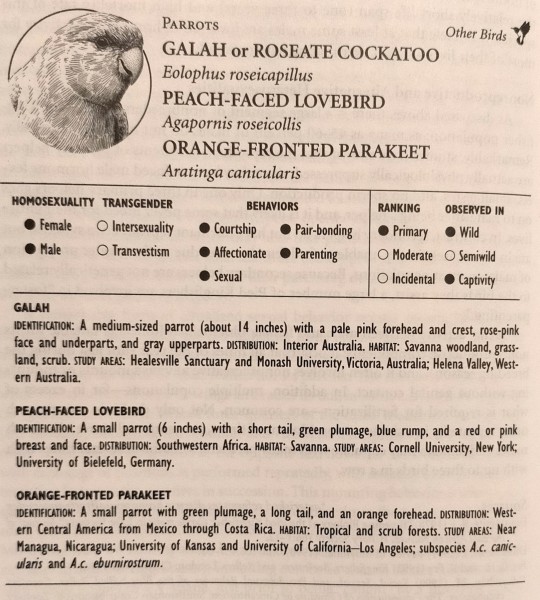
"Biological Exuberance: Animal Homosexuality and Natural Diversity" - Bruce Bagemihl
#book quotes#biological exuberance#bruce bagemihl#nonfiction#galah#roseate cockatoo#eolophus roseicapillus#peach faced lovebird#agapornis roseicollis#orange fronted parakeet#aratinga canicularis#gregarious#flock#social
0 notes
Text


Today’s pixel art bird is the emerald toucanet! I saw this one over the summer. I spotted it through a window over breakfast and raced outside to get a better look. It did spook some orange fronted parakeets with its arrival.
They are among the smaller toucan species, and are a fairly social, omnivorous species with an appetite for fruit. The funky thing about taxonomy is whether something is a species depends on who you ask. For example, the International Ornithological Congress may not concur with the American Ornithological Society, which may not concur with Jim Clements, author of Clements Checklist of Bird of the World.
So this might be a northern emerald toucanet according to the IOC, but as that all confuses me a great deal, I think I am satisfied calling it an emerald toucanet for now.
P.S. You can find this pixel art as a sticker here. :3
7 notes
·
View notes
Photo

Orange fronted Parakeet (NLOTGW style) by GreenWingSpino32
More parrots!
Art (c) GreenWingSpino32
#spinoblogs#spinoart#orange fronted parakeet#orange fronted parakeets#parakeet#parakeets#parrot#parrots#orange fronted parrots#orange fronted parrot#central america#central american birds#mexico#costa rica#central american fauna#post#art post#paint tool sai art#paint tool sai#birds#bird#birblr#birdlr
5 notes
·
View notes